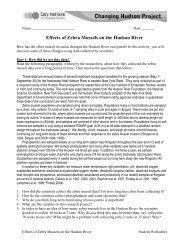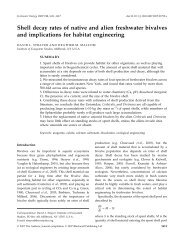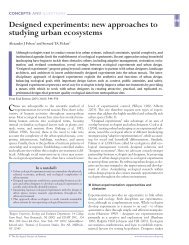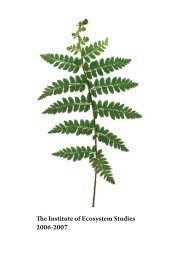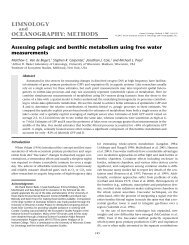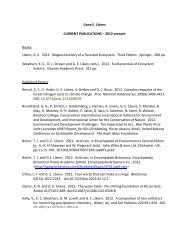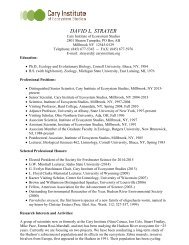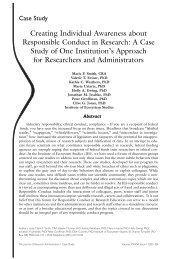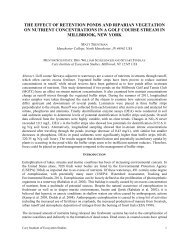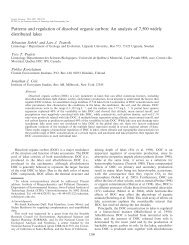Patch dynamics in a landscape modified by ecosystem engineers
Patch dynamics in a landscape modified by ecosystem engineers
Patch dynamics in a landscape modified by ecosystem engineers
You also want an ePaper? Increase the reach of your titles
YUMPU automatically turns print PDFs into web optimized ePapers that Google loves.
ConclusionsThe set of models developed here helps l<strong>in</strong>k thepopulation <strong>dynamics</strong> of <strong>ecosystem</strong> eng<strong>in</strong>eers to the<strong>dynamics</strong> of the patches that they create. By predict<strong>in</strong>gthe relative abundance of eng<strong>in</strong>eered and uneng<strong>in</strong>eeredpatches <strong>in</strong> a <strong>landscape</strong>, it has the potential to serve as animportant tool <strong>in</strong> determ<strong>in</strong><strong>in</strong>g the effects of <strong>ecosystem</strong>eng<strong>in</strong>eers on <strong>ecosystem</strong> structure and function at the<strong>landscape</strong> scale. Application of the model to a populationof beaver <strong>in</strong> the central Adirondack Mounta<strong>in</strong>ssuggests that because successful colonization rates arelow and site abandonment rates are high, the populationpersistence may depend on dispersers from beavercolonies <strong>in</strong> un<strong>modified</strong> patches such as natural lakes.Although we are not aware of any data set that wouldallow for complete parameterization of the model,analysis of the model suggests a number of possibletests of its structure and assumptions. The model makesnumerous testable predictions about how the distributionof patch types <strong>in</strong> a <strong>landscape</strong> should change <strong>in</strong>response to changes <strong>in</strong> the population <strong>dynamics</strong> ofeng<strong>in</strong>eers or the recovery rate of patches after theyhave been abandoned. Furthermore, <strong>by</strong> comb<strong>in</strong><strong>in</strong>g thismodel with an understand<strong>in</strong>g of how <strong>ecosystem</strong> eng<strong>in</strong>eer<strong>in</strong>gaffects diversity at the <strong>landscape</strong> scale, we nowhave the tools to relate the population <strong>dynamics</strong> of anorganism to patterns of <strong>landscape</strong>-level diversity.Acknowledgements / The authors gratefully acknowledge theAdirondack Ecological Center for access to the long-term dataset on beaver <strong>dynamics</strong> of the Hunt<strong>in</strong>gton Wildlife Forest.Special thanks to C. Demers and R. Sage for their help <strong>in</strong>organiz<strong>in</strong>g and ma<strong>in</strong>ta<strong>in</strong><strong>in</strong>g this valuable resource. A. Flecker, P.Marks, B. Goodw<strong>in</strong>, R. Root and P. Nummi provided manyuseful comments and suggestions for improv<strong>in</strong>g the manuscript.This work was funded <strong>by</strong> Sigma Xi, the Laurel Foundation, theKieckhefer Adirondack Fellowship, the Institute of EcosystemStudies, and an NSF GRT for Human AcceleratedEnvironmental Change. This study is a contribution to theInstitute of Ecosystem Studies.ReferencesBarnes, W. J. and Dibble, E. 1986. The effects of beaver <strong>in</strong>riverbank forest succession. / Can. J. Bot. 66: 40/44.Beer, J. R. 1955. Movements of tagged beaver. / J. Wildl.Manage. 19: 492/493.Bergerud, A. T. and Miller, D. R. 1977. Population <strong>dynamics</strong> ofNewfoundland beaver. / Can. J. Zool. 55: 1480/1492.Coleman, F. C. and Williams, S. L. 2002. Overexploit<strong>in</strong>g mar<strong>in</strong>e<strong>ecosystem</strong> eng<strong>in</strong>eers: potential consequences for biodiversity./ Trends Ecol. Evol. 17: 40/43.Coll<strong>in</strong>s, S. L. and Uno, G. E. 1983. The effect of early spr<strong>in</strong>gburn<strong>in</strong>g on vegetation <strong>in</strong> buffalo wallows. / Bull. TorreyBot. Club 110: 474/481.Crooks, J. A. 2002. Characteriz<strong>in</strong>g <strong>ecosystem</strong>-level consequencesof biological <strong>in</strong>vasions: the role of <strong>ecosystem</strong>eng<strong>in</strong>eers. / Oikos 97: 153/166.Fryxell, J. M. 2001. Habitat suitability and source-s<strong>in</strong>k<strong>dynamics</strong> of beavers. / J. Anim. Ecol. 70: 310/316.Grover, A. M. and Baldassarre, G. A. 1995. Bird speciesrichness with<strong>in</strong> beaver ponds <strong>in</strong> south-cenral New York./ Wetlands 15: 108/118.Guo, Q. 1996. Effects of bannertail kangaroo rat mounds onsmall-scale plant community structure. / Oecologia 106:247/256.Gurney, W. S. C. and Lawton, J. H. 1996. The population<strong>dynamics</strong> of <strong>ecosystem</strong> eng<strong>in</strong>eers. / Oikos 76: 273/283.Hanson, W. D. and Campbell, R. S. 1963. The effects of poolsize and beaver activity on distribution and abundance ofwarm-water fishes <strong>in</strong> a north Missouri stream. / Am. Midl.Nat. 69: 136/149.Hibbard, E. A. 1958. Movements of beaver transplanted <strong>in</strong>North Dakota. / J. Wildl. Manage. 22: 209/211.Howard, R. J. and Larson, J. S. 1985. A stream habitatclassification system for beaver. / J. Wildl. Manage. 49:19/25.Huntly, N. J. and Inouye, R. S. 1988. Pocket gophers <strong>in</strong><strong>ecosystem</strong>s: patterns and mechanisms. / BioScience 38:786/793.Ives, R. L. 1942. The beaver/meadow complex. / J. Geomorph.5: 191/203.Jenk<strong>in</strong>s, S. H. and Busher, P. E. 1979. Castor canadensis./ Mammalian Species 120: 1 /8.Johnston, C. A. and Naiman, R. J. 1990a. Aquatic patchcreation <strong>in</strong> relation to beaver population trends. / Ecology71: 1617/1621.Johnston, C. A. and Naiman, R. J. 1990b. Browse selection <strong>by</strong>beaver: effects on riparian forest composition. / Can. J. For.Res. 20: 1036/1043.Johnston, C. A. and Naiman, R. J. 1990c. The use of ageographic <strong>in</strong>formation system to analyze long-term <strong>landscape</strong>alteration <strong>by</strong> beaver. / Landscape Ecol. 4: 5 /19.Johnston, C. A., P<strong>in</strong>ay, G., Arens, C. et al. 1995. Influence ofsoil properties on the biogeochemistry of a beaver meadowhydrosequence. / Soil Sci. Soc. Am. J. 59: 1789/1799.Jones, C. G., Lawton, J. H. and Shachak, M. 1994. Organismsas <strong>ecosystem</strong> eng<strong>in</strong>eers. / Oikos 69: 373/386.Jones, C. G., Lawton, J. H. and Shachak, M. 1997. Positive andnegative effects of organisms as physical <strong>ecosystem</strong> eng<strong>in</strong>eers./ Ecology 78: 1946/1957.Knudson, G. J. 1962. Relationship of beavers to forests, troutand wildlife <strong>in</strong> Wiscons<strong>in</strong>. Tech. Bull. No. 25. / Wiscons<strong>in</strong>Conserv. Dept.Leege, T. A. 1968. Natural movements of beavers <strong>in</strong> southeasternIdaho. / J. Wildl. Manage. 32: 973/976.Lill, J. T. and Marquis, R. J. 2003. Ecosystem eng<strong>in</strong>eer<strong>in</strong>g <strong>by</strong>caterpillars <strong>in</strong>creases <strong>in</strong>sect herbivore diversity on white oak./ Ecology 84: 682/690.Margolis, B. E., Castro, M. S. and Raesly, R. L. 2001. Theimpact of beaver impoundments on the water chemistry oftwo Appalachian streams. / Can. J. Fish. Aquat. Sci. 58:2271/2283.Mart<strong>in</strong>sen, G. D., Driebe, E. M. and Whitham, T. G. 1998.Indirect <strong>in</strong>teractions mediated <strong>by</strong> chang<strong>in</strong>g plant chemistry:beaver brows<strong>in</strong>g benefits beetles. / Ecology 79: 192/200.McDowell, D. M. and Naiman, R. J. 1986. Structure andfunction of a benthic <strong>in</strong>vertebrate stream community as<strong>in</strong>fluenced <strong>by</strong> beaver (Castor canadensis). / Oecologia 68:481/489.McMaster, R. T. and McMaster, N. D. 2000. Vascular flora ofbeaver wetlands <strong>in</strong> western Massachusetts. / Rhodora 102:175/197.Naiman, R. J., Melillo, J. M. and Hobbie, J. E. 1986. Ecosystemalteration of boreal forest streams <strong>by</strong> beaver (Castorcanadensis). / Ecology 67: 1254/1269.Nummi, P. 1989. Simulated effects of the beaver on vegetation,<strong>in</strong>vertebrates and ducks. / Ann. Zool. Fenn. 26: 43/52.Nummi, P. and Poysa, H. 1997. Population and communitylevel responses <strong>in</strong> Anas-species to patch disturbance caused<strong>by</strong> an <strong>ecosystem</strong> eng<strong>in</strong>eer, the beaver. / Ecography 20: 580/584.OIKOS 105:2 (2004) 347



